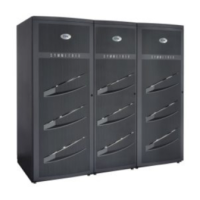198
EMC Symmetrix DMX-3 Product Guide
Data Integrity, Availability, and Protection
Symmetrix DMX RAID 5
This section describes the RAID 5 (3+1) and RAID 5 (7+1) features.
RAID 5 overview
The Symmetrix DMX-3 supports RAID 5 data protection. RAID 5 is
architected around block-based multispindle parity protection.
RAID 5 implements data striping and rotating parity across all
hypervolumes of a RAID 5 device. The hypervolumes must reside on
different physical disks.
The following sections describe how RAID 5 functions in Symmetrix
systems:
◆ “RAID 5 attributes” on page 198
◆ “RAID 5 device (volume)” on page 198
◆ “RAID 5 (3+1)” on page 199
◆ “RAID 5 (7+1)” on page 199
◆ “RAID 5 modes of operation” on page 199
◆ “RAID 5 performance optimization” on page 204
◆ “RAID 5 configuration rules” on page 205
RAID 5 attributes
A RAID 5 device has the following attributes:
◆ RAID 5 track size is 64 KB.
◆ Data blocks are striped (or interleaved) horizontally across the
members of a RAID 5 group, similar to a striped metavolume.
Each member owns some data tracks and some parity tracks.
◆ RAID 5 groups can be:
• Four members per logical device, RAID 5 (3+1)
• Eight members per logical device, RAID 5 (7+1)
RAID 5 device
(volume)
A RAID 5 device (logical volume) is made of four or eight
hypervolumes each with tracks of data and a parity that rotate.
RAID 5 stripes both data and parity across all hypervolumes of the
RAID 5 device. The entire set of RAID 5 hypervolumes is presented to
the host as a single RAID 5 device. Figure 43 on page 199 shows a
RAID 5 device consisting of four Symmetrix hypervolumes on four
separate physical drives with one RAID 5 (3+1) device defined.

